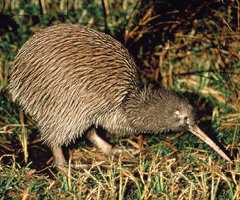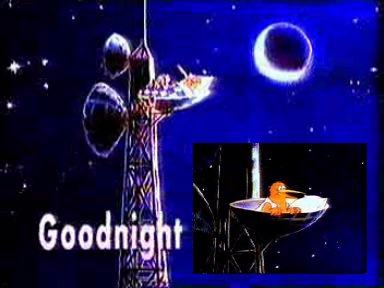
|
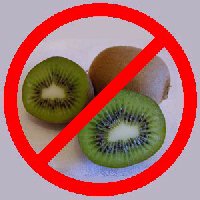 |

|
That would be a kiwiFRUIT.
| To confuse the two is to betray a lack of awareness that seems to predominantly afflict Americans - and to offend an entire nation into the bargain. |
|
Bad for business. |
|
More detail (and some rambling anecdotes) |
||||||
Kiwi are chicken-sized brown or spotted flightless birds, named by the maori of New Zealand for the shrill cry of the male (the larger female has a deeper, throatier call).
Kiwi inhabit areas with ground cover, from the lowlands to sub-alpine areas, from the top of the North Island, south to Stewart island. Kiwi were once common, but are now gone from most areas due to predation by newly introduced animals. As odd as the kiwi looks, there are yet more surprises in store, with many unusual mammal-like features: 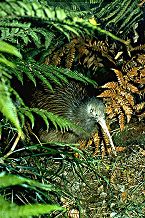 Apart from being flightless, kiwi have other un-birdlike characteristics. They have no tail, and their useless vestigial wings, only about 5cm long, are invisible among the fine, fur-like feathers (these feathers were prized by the native maori for making cloaks, in a country with no fur animals). While most birds are active during the day, and have good vision (necessary for flying), and poor sense of smell, the kiwi is nocturnal, with poor vision... but an excellent sense of smell. They have been observed with head thrown back, beak high in the air, scenting the wind wolfishly to determine the whereabouts of other animals.
Apart from being flightless, kiwi have other un-birdlike characteristics. They have no tail, and their useless vestigial wings, only about 5cm long, are invisible among the fine, fur-like feathers (these feathers were prized by the native maori for making cloaks, in a country with no fur animals). While most birds are active during the day, and have good vision (necessary for flying), and poor sense of smell, the kiwi is nocturnal, with poor vision... but an excellent sense of smell. They have been observed with head thrown back, beak high in the air, scenting the wind wolfishly to determine the whereabouts of other animals. 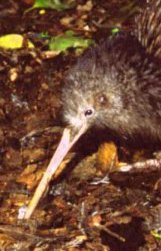 Unique among birds a kiwi's nostrils are right at the tip of its long slender beak, with which it probes the soil and leaf-litter, looking for bugs to eat,
as it moves snuffling about the forest floor (aside from this long beak, kiwi look similar to the weka, another native flightless bird. Indeed, the maori name for a South Island kiwi is "Tokoeka", where 'toko' is maori for
Unique among birds a kiwi's nostrils are right at the tip of its long slender beak, with which it probes the soil and leaf-litter, looking for bugs to eat,
as it moves snuffling about the forest floor (aside from this long beak, kiwi look similar to the weka, another native flightless bird. Indeed, the maori name for a South Island kiwi is "Tokoeka", where 'toko' is maori for
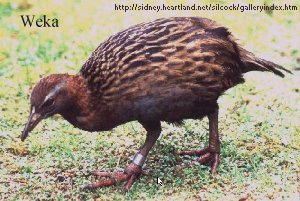 walking-stick: the weka with a walking-stick), and will also eat berries and fruit if it finds them. Kiwi have very large (but not obvious) ears, and at the base of their long beak are mammal-like whiskers, useful for night time navigation on the dark forest floor.
walking-stick: the weka with a walking-stick), and will also eat berries and fruit if it finds them. Kiwi have very large (but not obvious) ears, and at the base of their long beak are mammal-like whiskers, useful for night time navigation on the dark forest floor. Kiwi have strong stout legs (the plural of kiwi is kiwi, much like the plural of fish is fish), widely spaced, they produce a distinctive heavy rolling gait, but can outsprint a human through the bush if pursued. These strong legs are used for digging for bugs, and for enlarging the burrows in which they live and nest.  These notoriously 'grumpy' and territorial birds also use their strong legs and sharp claws for fighting. Because they are so combatively territorial, Department of Conservation staff can attract them simply by imitating their call:
These notoriously 'grumpy' and territorial birds also use their strong legs and sharp claws for fighting. Because they are so combatively territorial, Department of Conservation staff can attract them simply by imitating their call: | ||||||
|
Incensed that another kiwi is on their turf, the response is instant and dramatic: "It's amazing to hear them coming to kick the intruder out. They sound like a deer charging, almost exploding, through the dark... 'Pete' is a Great Spotted Kiwi in West Northland. "We've just got to walk into his territory and he comes catapulting in for a hit-and-run. He belts you in the leg and then runs off into the undergrowth..." Quoted from: Mercury Bay Online's Kiwi Information Page |
One of the amazing things about kiwi is the size of their eggs.
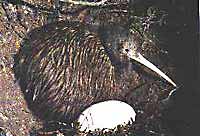 Despite adults being about the size of a chicken (5 to 9 pounds, or 2.3 to 4.1 kg), the size of a kiwi egg is closer to that of an ostrich, 6 times as big as a chicken's egg, and weighing up to 20% of the mother's body weight. Not surprisingly, only one egg is laid at a time, after which the female goes off, leaving the male to incubate the egg by himself for the 11 weeks it takes to hatch (pairs bond for life, but share a loose living arrangement. Although some southern kiwi are known to live in small groups, kiwi are usually far too territorial for this). One to 2 eggs are laid yearly, and if a second ivory to pale-green egg is laid while the first is being incubated, males can lose over 1/3 of their body weight during the prolonged incubation period as they will have few opportunities to forage.
Despite adults being about the size of a chicken (5 to 9 pounds, or 2.3 to 4.1 kg), the size of a kiwi egg is closer to that of an ostrich, 6 times as big as a chicken's egg, and weighing up to 20% of the mother's body weight. Not surprisingly, only one egg is laid at a time, after which the female goes off, leaving the male to incubate the egg by himself for the 11 weeks it takes to hatch (pairs bond for life, but share a loose living arrangement. Although some southern kiwi are known to live in small groups, kiwi are usually far too territorial for this). One to 2 eggs are laid yearly, and if a second ivory to pale-green egg is laid while the first is being incubated, males can lose over 1/3 of their body weight during the prolonged incubation period as they will have few opportunities to forage. With their slender supple beaks, kiwi chicks don't peck their way out like most birds, but use their powerful stompers to kick the eggshell apart. 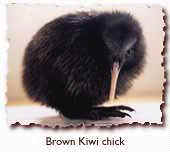 Chicks from these huge eggs are well developed at birth, and are not fed by the adults, venturing out to forage for themselves at about 1 week, some leave the nest permanently at just 2 weeks. This is where kiwi are
vulnerable. Although adult kiwi can fend off most NZ predators except dogs, and some individuals are known to be over 40 years old, newly introduced stoats are blamed with taking 60% of all chicks in their first year, and with kiwi laying so few eggs annually, their population is estimated to be declining at about 5.8% per year.
Chicks from these huge eggs are well developed at birth, and are not fed by the adults, venturing out to forage for themselves at about 1 week, some leave the nest permanently at just 2 weeks. This is where kiwi are
vulnerable. Although adult kiwi can fend off most NZ predators except dogs, and some individuals are known to be over 40 years old, newly introduced stoats are blamed with taking 60% of all chicks in their first year, and with kiwi laying so few eggs annually, their population is estimated to be declining at about 5.8% per year. New Zealand is one of the most isolated large-island groups in the world, separated from other lands since the end of the Cretaceous period 130 million odd years ago. At this time there were no large predators on New Zealand, and our flora and fauna continued to dream in a South Pacific paradise with no mammals, many birds came to dwell on the ground, growing big and heavy and losing the redundant ability to fly with no predators to escape (The only native land mammals were two species of small bats), and most food sources being on or near the forest floor. Kiwi are the smallest of the ratites, an early group of birds with no wing-keel on their breast bone, they include many large flightless birds, such as ostrich, emu, rhea, and cassowary, and the extinct moa and elephant bird. There are 4 species of kiwi (some say 6, it is unclear whether some races are actually distinct species), all of them unique to New Zealand. 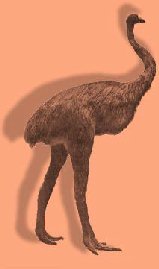 Aside from Kiwi there were
Aside from Kiwi there were
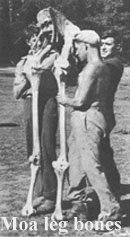 many other flightless birds in New Zealand, and these were abundant and successful until the coming of the first humans, thought to have occured as recently as 1000 AD. These people brought with them rats and dogs, hunting and burning. Over the following 800 years many species became extinct, including the Moa,
a group of flightless birds (with no wings at all), which ranged from turkey size, to tree-browsers stretching to over 3 metres (10 foot) tall, the tallest birds ever known to exist.
many other flightless birds in New Zealand, and these were abundant and successful until the coming of the first humans, thought to have occured as recently as 1000 AD. These people brought with them rats and dogs, hunting and burning. Over the following 800 years many species became extinct, including the Moa,
a group of flightless birds (with no wings at all), which ranged from turkey size, to tree-browsers stretching to over 3 metres (10 foot) tall, the tallest birds ever known to exist. Only about 200 years ago Europeans started settling New Zealand, clearing and burning forest, they brought with them many bird-killers: cats, rats, dogs, ferrets, weasels, stoats, possums, and most recently, cars. Now only 2 types of native flightless birds persist with any real numbers, the Kiwi and the Weka, though these too, are endangered. It is estimated that in 1923 there were 5 million kiwi, in 1999 about 70,000. Both Maori and immigrant New Zealanders have thus come to respect and identify with this special and unusual character, uniquely New Zealand, and revealed to be all the more exceptional the closer you look. Around 1886 the kiwi symbol was being used on regimental badges, and during World War 1, NZ troops carved a giant kiwi into the chalk hillside above their camp in England. The kiwi quickly become adopted and recognised as a symbol of New Zealand, especially when New Zealanders, kiwis, went overseas. The term "kiwi" was not patented, and as early as 1906 it was 'poached' by an  Australian who had married a New Zealand wife, as the name for his shoe-polish, complete with a logo depicting a kiwi.
Today, Kiwi Polish is one of the largest, most widely known shoe-polish brands in the world - and even many New Zealander's believe it is a New Zealand company.
Australian who had married a New Zealand wife, as the name for his shoe-polish, complete with a logo depicting a kiwi.
Today, Kiwi Polish is one of the largest, most widely known shoe-polish brands in the world - and even many New Zealander's believe it is a New Zealand company.  In the 20th century kiwi emblems came to be used everywhere as a symbol of New Zealand, rivaled only by the Silver Fern and the New Zealand flag (which is woefully unoriginal and colonial - we need a new flag that better reflects our country - Canada eventually did, and now their flag is instantly and unmistakably recognisable anywhere).
In the 20th century kiwi emblems came to be used everywhere as a symbol of New Zealand, rivaled only by the Silver Fern and the New Zealand flag (which is woefully unoriginal and colonial - we need a new flag that better reflects our country - Canada eventually did, and now their flag is instantly and unmistakably recognisable anywhere).
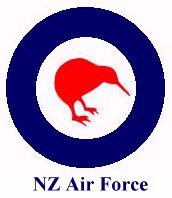 Among many other places, kiwi symbols can be found on Airforce planes, on NZ made products, on the old 20-cent piece (many of which are still in circulation), and the relatively new NZ$1 coin. Kiwis feature in the coat of arms, crests and badges of many New Zealand cities, clubs and organisations.
Among many other places, kiwi symbols can be found on Airforce planes, on NZ made products, on the old 20-cent piece (many of which are still in circulation), and the relatively new NZ$1 coin. Kiwis feature in the coat of arms, crests and badges of many New Zealand cities, clubs and organisations. 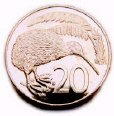 The "goodnight kiwi" would be remembered by any New Zealander over 20 years old. For years when the TV network closed-down for the evening around mid-night, the last thing played before your TV screen went blank was a short animation of a cartoon kiwi (and his cat), shutting down the studio and
The "goodnight kiwi" would be remembered by any New Zealander over 20 years old. For years when the TV network closed-down for the evening around mid-night, the last thing played before your TV screen went blank was a short animation of a cartoon kiwi (and his cat), shutting down the studio and
 turning off the lights before bedding down in an upturned transmitter dish on the antenna mast.
turning off the lights before bedding down in an upturned transmitter dish on the antenna mast. No-one thought it strange then, that when NZ was the worlds leading exporter of high quality Chinese Gooseberries (Actinidia deliciosa) from the 1960's to the 1980's, they were given the new, catchier name of "kiwifruit", as a marketing ploy to associate them with NZ, rather than China whence they originated (especially as China was an international outcast in these times). Kiwifruit were largely developed as a household fruit by this New Zealand 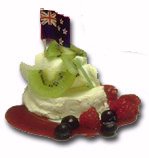 marketing. Early in the 1900's they were still just growing wild in their native high grasslands, low scrub and forests of China and Siberia, although eaten by some there as a delicacy called Yang Tao. In 1904 Katie Fraser brought some home to Wanganui in NZ, and they thrived in the conditions provided by some areas of New Zealand. Having more pottasium than bananas, and more than twice as much vitamin C as oranges, kiwifruit are not a tropical fruit as many foreign consumers believe, although they cannot tolerate extremely low winter temperatures, and do require a long growing season (over 200 days) - conditions found in many areas of mild temperate NZ.
marketing. Early in the 1900's they were still just growing wild in their native high grasslands, low scrub and forests of China and Siberia, although eaten by some there as a delicacy called Yang Tao. In 1904 Katie Fraser brought some home to Wanganui in NZ, and they thrived in the conditions provided by some areas of New Zealand. Having more pottasium than bananas, and more than twice as much vitamin C as oranges, kiwifruit are not a tropical fruit as many foreign consumers believe, although they cannot tolerate extremely low winter temperatures, and do require a long growing season (over 200 days) - conditions found in many areas of mild temperate NZ. Re-branding them "Kiwifruit" worked very well, and NZ grew the kiwifruit  market from nothing to a multi-million dollar trade by the late 1970's (although this is not the reason that foreign exchange markets refer to NZ currency as "the kiwi" - currently around 1/2 the value of "the greenback", or 1/3 the value of "sterling"). But the exporters hadn't learnt the lesson from 1906, the new name was not patented, and the successful marketing of "kiwifruit" played into the hands of others.
market from nothing to a multi-million dollar trade by the late 1970's (although this is not the reason that foreign exchange markets refer to NZ currency as "the kiwi" - currently around 1/2 the value of "the greenback", or 1/3 the value of "sterling"). But the exporters hadn't learnt the lesson from 1906, the new name was not patented, and the successful marketing of "kiwifruit" played into the hands of others. Soon other countries were planting and then exporting large amounts of the fruit, getting in on the action of a booming market, and in the 1980's most "kiwifruit" on the world market were being grown outside of kiwi-land. When the New Zealand 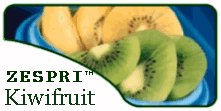 exporters of kiwifruit realised that their
brand-name was no longer unique to NZ product, it was too late to trademark the new name, and they changed their name to
Zespri (trademarked, and still producing the highest quality kiwifruit in the world, as well as developing new varieties, such as the sweeter, hairless, yellow-fleshed "Zespri Gold"), but by this time the abbreviation 'kiwi' had become a household name in countries that knew little of New Zealand, and were ignorant of what a real kiwi was.
exporters of kiwifruit realised that their
brand-name was no longer unique to NZ product, it was too late to trademark the new name, and they changed their name to
Zespri (trademarked, and still producing the highest quality kiwifruit in the world, as well as developing new varieties, such as the sweeter, hairless, yellow-fleshed "Zespri Gold"), but by this time the abbreviation 'kiwi' had become a household name in countries that knew little of New Zealand, and were ignorant of what a real kiwi was. Primarily it is north americans and asians that i encounter making this error,and it reflects poorly on them. Certainly most in continental Europe, England, Scotland, and Wales know who a kiwi is, and that the fruit is called a kiwifruit. It became clear that part of the problem in north america comes from poor 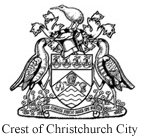 reporting standards. This was highlighted when "Good Morning America" came to New Zealand, and yet still managed to report
that New Zealander's were so crazy about kiwifruit we had named ourselves after them. Investigative journalism at its best.
reporting standards. This was highlighted when "Good Morning America" came to New Zealand, and yet still managed to report
that New Zealander's were so crazy about kiwifruit we had named ourselves after them. Investigative journalism at its best. Just as some foreigners are unaware that they are mis-using the term kiwi, many New Zealanders are unaware that some foreigners don't know what a kiwi is. 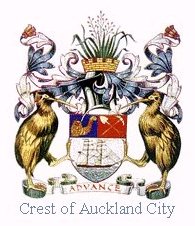 New Zealanders tend to be rightly proud of our mountainous south-pacific home, valuing it's uncrowded remoteness, easy-going culture, good standard of living - and unique wildlife.
Kiwis are thus often offended to hear kiwifruit called "kiwi"s, and to discover that when we proudly say we are
kiwis, some uninformed people believe we are naming ourselves after fruit, belittling our symbol of all that is unique about New Zealand to a fuzzy tart fruit.
New Zealanders tend to be rightly proud of our mountainous south-pacific home, valuing it's uncrowded remoteness, easy-going culture, good standard of living - and unique wildlife.
Kiwis are thus often offended to hear kiwifruit called "kiwi"s, and to discover that when we proudly say we are
kiwis, some uninformed people believe we are naming ourselves after fruit, belittling our symbol of all that is unique about New Zealand to a fuzzy tart fruit. Since first encountering this continent-wide confusion whilst travelling in north america, this particular kiwi has repeatedly tried to educate those that betray this fault. Of course the scale of the problem makes this futile ("Good Morning America" had the chance, but must have been more interested in having a holiday than informing their audience), and to save time i have assembled this web-page so that in future i can simply recommend the offender check this address and perhaps in future avoid treading on the toes of an entire nation. Another has this to say on their web-page: 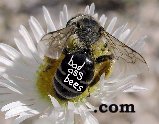 BadAssBees Index Email Me Since 4/7/2 |
